India recently reduced import tariffs on motorcycles in an effort to strengthen trade relations with the United States and alleviate tariff threats from President Trump. With bilateral trade exceeding $190 billion, India enjoys a trade surplus with the US but faces pressures for a more balanced trade relationship, particularly concerning agricultural market access. Experts express concern over the potential for retaliatory trade measures, emphasizing India’s strategic ties and the importance of high-level discussions between leaders.
India has taken steps to mitigate tariff threats from the United States by reducing import duties on motorcycles, specifically decreasing tariffs on heavyweight bikes from 50% to 30% and smaller models from 50% to 40%. This move is aimed at facilitating Harley Davidson’s entry into the Indian market while addressing potential tariffs by the US, which last year saw motorcycle exports from the US valued at $3 million.
As President Donald Trump resumes his administration, he has indicated a desire to pursue trade measures affecting both allies and rivals, including India. There is apprehension in India regarding whether these tariff reductions will satisfy Trump’s demands for a more balanced trade relationship. Trade expert Ajay Srivastava highlighted Trump’s previous actions against Canada and Mexico as a cause for concern, emphasizing that India may not be exempt from similar treatment.
During a recent conversation, President Trump urged Prime Minister Narendra Modi to purchase more American arms and sought a fairer trade arrangement. Trump has often criticized India’s high tariffs, labeling the country’s previous 100% levies on Harley Davidson motorcycles as “unacceptable” and referring to India as a “tariff king” due to its aggressive trade policies.
Despite high tariffs, India maintains a trade surplus with the US, being its largest trading partner. The bilateral trade in 2023 reached $190 billion, with Indian exports surging significantly. Recent tariff reductions are also evident in sectors such as satellite installations, synthetic flavoring essences, and fish hydrolysates, which indicate an effort to enhance US export opportunities.
India’s diverse export portfolio includes textiles, pharmaceuticals, and machinery, showcasing its robust global trade relationship with the US. Once known for its protectionist economic policies, India has evolved since the 1990s to become more trade-friendly, having reduced average tariffs significantly, although recent policies have seen a rebound in import taxes driven by the ‘Make in India’ initiative.
Experts believe that under Trump’s “America First” policy, India may be seen as a candidate for retaliatory actions due to its import tariffs. However, agricultural access remains contentious, and India has recently lifted retaliatory tariffs on various US agricultural products while navigating domestic sensitivities around agriculture. Expert Biswajit Dhar has warned that this could lead to challenges in negotiations, as both countries seek advantageous trade conditions.
The focus of this article is on India’s strategic adjustments in trade policies amid potential tariff threats from the United States under President Donald Trump. Historically, India has maintained high tariffs, but recent efforts have aimed to reduce these barriers to foster stronger economic ties, especially in light of the US’s aggressive trade stances. This backdrop highlights India’s balancing act between maintaining beneficial trade with the US while addressing domestic political concerns surrounding industry and agriculture. Trade officials and experts are closely monitoring this evolving relationship, especially as personal ties between the leaders and strategic alliances come into play.
In conclusion, India’s recent reduction of import duties demonstrates a proactive approach to managing trade relations with the United States amidst looming tariff threats from President Trump. While India benefits from a trade surplus and a diverse export base, it must navigate delicate negotiations around tariffs and agricultural access. As both nations seek to enhance their economic relationship, the potential for conflict remains, yet strategic alignment may mitigate some of the challenges ahead.
Original Source: www.bbc.com






